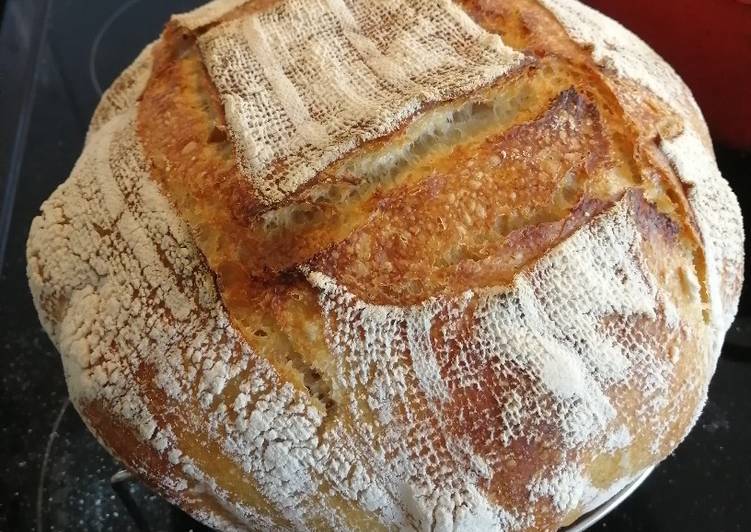Recipe: Appetizing Sourdough bloomer
Sourdough bloomer. Download high-quality Fresh crusty sourdough bloomer bread loaf images, illustrations and vectors perfectly priced to fit your projects budget. A Bloomer is someone with a bright outlook on life who is optimistic in nature. Here i'm shaping a couple of oblong loaves from a quite-sticky spent brewing grain dough.
 Elaine, I love the sourdough recipes you provide. Because of you and using your master recipe it has helped me. Baking with sourdough Doomer - bloomer. You can cook Sourdough bloomer using 5 ingredients and 10 steps. Here is how you achieve it.
Elaine, I love the sourdough recipes you provide. Because of you and using your master recipe it has helped me. Baking with sourdough Doomer - bloomer. You can cook Sourdough bloomer using 5 ingredients and 10 steps. Here is how you achieve it.
Ingredients of Sourdough bloomer
- You need 450 g of bread flour.
- It's 50 g of kamut flour.
- It's 100 g of sourdough starter.
- You need 350 ml of warm water.
- It's 20 ml of water mixed with 10g salt.
Paul Hollywood shows you how to make a simple sourdough starter culture of flour, water and grapes so you can make a whole range of delicious sourdough breads at home. Want to learn how to make and bake sourdough? Love the aroma, taste, and texture of homemade bread? If yes, this is your subreddit!
Sourdough bloomer instructions
- In a large bowl, mix together the bread and kamut flour, the warm water and the sourdough starter, then cover with a hot wet cloth and leave to rest for 30 mins at room temperature, to allow all the ingredients to bond.
- Add the salted water to the mixture and knead together. Adding the salt now will help tighten up the dough, allowing you to tuck the sides under to shape. Cover with a wet cloth and leave to rest for 30 mins at room temperature.
- Now stretch and fold your dough, to let that gluten work and create some structure. To do so, grab a "corner" of your dough and gently pull it outward, stretching and waving it, then fold it on its own. Repeat until the edges all around the dough have been pulled and folded. Cover with a wet cloth and leave to rest for 30 mins at room temperature.
- Repeat step 3 about 5-6 times, letting your dough rest for 30mins in between stretches. Then let it rest for at least 1-2 hours.
- Now you can shape: get your dough on a floured surface, and pull it into a square. Now fold the corners in, in a cross stitch manner. Then fold it 4 times on its own: pull the bottom 1 third up, then the top 1 third down, and the left and right sides 1 third in. Turn your dough upside down, and start sliding it on the surface in order to tighten and seal the bottom. Let it rest a few seconds, to allow the dough to completely seal underneath.
- Time for proofing: generously flour your proofing basket (or you can use a bowl lined with a dry, clean tea towel like I do) and tip your dough in it upside down. Cover and let it rest at room temperature for 1-2hours, then in the fridge overnight.
- Once the dough has risen, preheat your oven at 220°, and leave your casserole or dutch oven in it to get really hot. Once you reached your temperature, flour the casserole or dutch oven, or line with a baking sheet, the tip the dough into it, and score the top of with a sharp knife. Cover with a lid and bake for 20 minutes. Leave a tray full of water in the oven during baking time, to allow extra moisture in.
- After 20 minutes, remove the lid and bake for another 20 minutes.
- Once the bread has cooked for 40 minutes, take it out of the oven and place on a cooling rack.
- Once it's completely cold, slice it and go ahead enjoying it on its own or with some delicious butter 😊.
Specialising in Nutrition & Digestibility of Bread & the Gut Microbiome. Most importantly of all, spelt flour makes the most delicious sourdough breads. Seeded Sourdough Lavash Crackers Made With Sourdough Discard And Other Goodness Don't get me wrong, I LOVE bread, and that's not going to change! Learn tips and tricks for troubleshooting your traditional sourdough starter. Sourdough bread, with its yeasty, lightly tangy flavor and buoyant crumb.